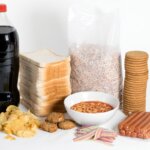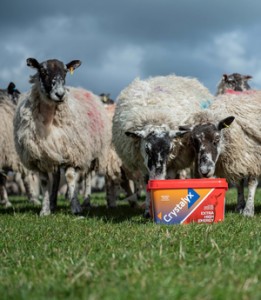New research highlights the importance of ensuring ewes are in appropriate condition at tupping, increasing the size of the lamb crop. The research at Aberystwyth University confirms the benefits of supplementing ewes with Crystalyx blocks at grass to achieve both target body condition and adequate trace minerals supply.
“AHDB data shows that ewes maintaining better body condition in mid-pregnancy, between tupping and scanning, typically have more lambs at scanning,” comments Crystalyx Technical Director Dr Cliff Lister. “To ensure ewes hit the target score of 3.5 for lowland breeds, it is important to make it a priority and to manage it proactively.”
He says over fat or thin ewes never perform well with many of them taking longer to come on heat. The oestrus period can also be erratic with fewer eggs being shed, leading to a greater percentage of ewes being barren, or prone to prolapse as well as increasing the chances of twin lamb disease.
He advises that weaning is the perfect time to condition score and deal with ewes outside the target score allowing them to recover condition once lambs have been removed.
“Thin ewes will need two months on good grass to put on one unit of body condition, typically equivalent to 10-11kg bodyweight for a lowland ewe. Fit ewes in good body condition, at least at the lower end of their target range will have good ovulation rates that will not normally be improved by a further increase in the plane of nutrition.”
Anything that disrupts grass quality and quantity will increase the risk of ewes failing to be in the correct condition at tupping. In addition, grass is frequently deficient in essential trace elements, such as zinc, cobalt, iodine and selenium.
Cobalt deficiency has been shown to result in a lower ovulation rate, poor egg quality and impaired embryo development in early pregnancy, while selenium and vitamin E deficiencies are associated with increased early embryonic mortality. A zinc deficiency will reduce immunity and the response to vaccination, giving rise to an increased risk of disease challenges.”
“Cost-effective supplementation can reduce these risks and have a big impact on the subsequent lamb crop as the trial at Aberystwyth University confirms,” Dr Lister continues. “The study compared performance of ewes on grazing alone with those on grazing supplemented with Crystalyx Extra High Energy feedblocks throughout the flushing to mid-pregnancy period.”
The supplemented ewes gained, and maintained, better weight and body condition in mid-pregnancy than ewes on grass alone, putting on an extra 3.9kg on average. At scanning the Crystalyx fed ewes were carrying 20% more lamb numbers, with fewer empty ewes, an increased number of twins but no increase in the number of triplets.
“The lambing percent per ewe tupped was 166% compared to 146%,” Dr Lister continues. “The benefit was even more pronounced at lambing where the lambing percent per ewe tupped was 156% as against 116% for the control ewes with fewer barren ewes and a higher proportion of twins. It is a possibility that the increased foetal retention is linked to improved immune status.
“In addition, the supplemented ewes lambed in a 22 day period compared to 49 days for the control group, indicating that the supplemented ewes were mated and conceived quicker while also producing more eggs at ovulation.
“In the trial period, ewes consumed on average 30g/day of the blocks at a cost of under 3p/ewe/day, ensuring a significant return on investment. By supplementing ewes to compensate for the natural and inevitable seasonal variations in grazing quality and quantity it is possible to ensure they maintain condition and are in the best physiological state to conceive and hold in lamb, increasing returns for a minimal investment,” Dr Lister concludes.











